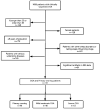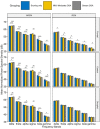EEG Power Spectral Analysis of Abnormal Cortical Activations During REM/NREM Sleep in Obstructive Sleep Apnea
- PMID: 33716946
- PMCID: PMC7953149
- DOI: 10.3389/fneur.2021.643855
EEG Power Spectral Analysis of Abnormal Cortical Activations During REM/NREM Sleep in Obstructive Sleep Apnea
Abstract
Objective: To characterize electroencephalogram (EEG) power in different frequency bands during rapid eye movement (REM) sleep and non-rapid eye movement (NREM) sleep in patients with obstructive sleep apnea (OSA). Methods: Retrospective data on 151 patients were collected and divided into three groups: primary snoring group (AHI < 5/h), mild-moderate OSA group (6 ≤ AHI < 30/h), and severe OSA group (AHI ≥ 30/h). EEG recordings in the frontal, central, and occipital regions were extracted from both REM and NREM sleep, to compute the normalized spectral power densities in the delta, theta, alpha, sigma, beta, and gamma frequency bands, using Fast Fourier Transform. Correlations between the computed EEG power and PSG parameters were analyzed. Results: In NREM sleep, elevated normalized power spectral density (PSD) in the delta band was observed in the severe OSA group compared to the other two groups. In contrast, the PSD of the other frequency bands showed a corresponding decrease in the severe OSA group. In REM sleep, similar changes were observed in the frontal region. Delta band PSD was positively correlated with Apnea Hypopnea Index (AHI) (r = 0.33), longest time of apnea, oxygen desaturation index (ODI) (r = 0.34), percent sleep time below 90% SaO2 (T90%) (r = 0.30), Arousal Index (ArI) (r = 0.29), and negatively correlated with N3%, minimum oxygen saturation (minSaO2). Conclusion: Our findings provide neurophysiological evidence for pathological cortical activation during REM/NREM sleep, which may be associated with the arousals and cognitive impairments in OSA. The technique of power spectral analysis could prove a potentially useful tool in complementing traditional PSG parameters in assessing disease burden to guide therapeutic decisions.
Keywords: REM and NREM sleep; normalized EEG power; obstructive sleep apnea; polysomnography; power spectral analysis.
Copyright © 2021 Liu, Shen, Li, Wang, Wang, Xu, Wang and Chen.
Conflict of interest statement
The authors declare that the research was conducted in the absence of any commercial or financial relationships that could be construed as a potential conflict of interest.
Figures



Similar articles
-
EEG Power Spectral Density in NREM Sleep is Associated with the Degree of Hypoxia in Patients with Obstructive Sleep Apnea.Nat Sci Sleep. 2023 Nov 27;15:979-992. doi: 10.2147/NSS.S433820. eCollection 2023. Nat Sci Sleep. 2023. PMID: 38046177 Free PMC article.
-
Quantitative electroencephalography measures in rapid eye movement and nonrapid eye movement sleep are associated with apnea-hypopnea index and nocturnal hypoxemia in men.Sleep. 2019 Jul 8;42(7):zsz092. doi: 10.1093/sleep/zsz092. Sleep. 2019. PMID: 31004167
-
Electroencephalography Theta/Beta Ratio Decreases in Patients with Severe Obstructive Sleep Apnea.Nat Sci Sleep. 2022 May 30;14:1021-1030. doi: 10.2147/NSS.S357722. eCollection 2022. Nat Sci Sleep. 2022. PMID: 35669412 Free PMC article.
-
The visual scoring of sleep and arousal in infants and children.J Clin Sleep Med. 2007 Mar 15;3(2):201-40. J Clin Sleep Med. 2007. PMID: 17557427 Review.
-
[Progress in clinical research of REM-related obstructive sleep apnea].Lin Chuang Er Bi Yan Hou Tou Jing Wai Ke Za Zhi. 2022 Feb;36(2):145-148. doi: 10.13201/j.issn.2096-7993.2022.02.015. Lin Chuang Er Bi Yan Hou Tou Jing Wai Ke Za Zhi. 2022. PMID: 35172555 Free PMC article. Review. Chinese.
Cited by
-
EEG spectral power during REM sleep in patients with frontal brain tumor.BMC Neurol. 2023 May 19;23(1):195. doi: 10.1186/s12883-023-03243-1. BMC Neurol. 2023. PMID: 37208614 Free PMC article.
-
Effect of continuous positive air pressure on cognitive impairment associated with obstructive sleep apnea.Zhong Nan Da Xue Xue Bao Yi Xue Ban. 2021 Aug 28;46(8):865-871. doi: 10.11817/j.issn.1672-7347.2021.190600. Zhong Nan Da Xue Xue Bao Yi Xue Ban. 2021. PMID: 34565731 Free PMC article. Chinese, English.
-
Transcranial magnetic stimulation cortical oscillations and improve cognition in obstructive sleep apnea patients.Brain Behav. 2023 Apr;13(4):e2958. doi: 10.1002/brb3.2958. Epub 2023 Mar 15. Brain Behav. 2023. PMID: 36922909 Free PMC article.
-
The effect of burst suppression on cerebral blood flow and autoregulation: a scoping review of the human and animal literature.Front Physiol. 2023 Jun 7;14:1204874. doi: 10.3389/fphys.2023.1204874. eCollection 2023. Front Physiol. 2023. PMID: 37351255 Free PMC article.
-
Lateralized differences in power spectra across different frequency bands during NREM sleep in patients with primary insomnia.Front Neurosci. 2025 Jan 21;19:1532011. doi: 10.3389/fnins.2025.1532011. eCollection 2025. Front Neurosci. 2025. PMID: 39906298 Free PMC article.
References
LinkOut - more resources
Full Text Sources
Other Literature Sources

